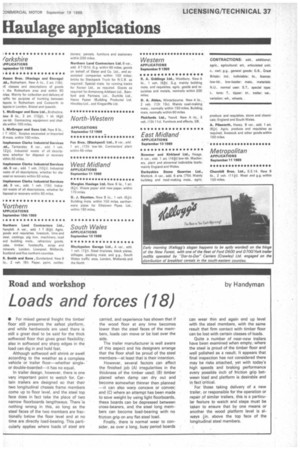Road and workshop by Handyman
Page 39

If you've noticed an error in this article please click here to report it so we can fix it.
Loads and forces (18)
• For mixed general freight the timber floor still presents the safest platform, and while hardwoods are used there is still a great deal to be said for the thick softwood floor that gives great flexibility; also in softwood any sharp edges in the load can dig in and hold fast.
Although softwood will shrink or swell according to the weather as a complete vehicle or trailer floor—whether singleor double-boarded—it has no equal.
In trailer design, however, there is one very important point to watch for. Certain trailers are designed so that their two longitudinal chassis frame members come up to floor level, and the steel top face does in fact take the place of two narrow floorboards lengthways. There 'is nothing wrong in this, so long as the steel faces of the two members are fractionally below the floor level and at no time are directly load-bearing. This particularly applies where loads of steel are carried, and experience has shown that if the wood floor at any time becomes lower than the steel faces of the members, loads can move or be lost over the side.
The trailer manufacturer is well aware of this aspect and his designers arrange that the floor shall be proud of the steel members—at least that is their intention.
However, several factors can affect the finished job (A) irregularities in the thickness of the timber used: (B) timber planed when damp can dry out and become somewhat thinner than planned —it can also warp concave or convex; and (C) where an attempt has been made to save weight by using light floorboards, these boards can be depressed between cross-bearers, and the steel long members can become load-bearing with no friction grip on any flat steel load.
Finally, there is normal wear to consider, as over a long, busy period boards can wear thin and again end up level with the steel members, with the same result that firm contact with timber floor can be lost with certain classes of loads.
Quite a number of near-new trailers have been examined when empty,' where the steel is proud of the timber floor and well polished as a result. It appears that final inspection has not considered there may be risks attached, yet with today's high speeds and braking performance every possible inch of friction grip between load and platform is desirable and in fact critical.
For. those taking delivery of a new trailer, or responsible for the operation or repair of similar trailers, this is a particular feature to watch and steps must be taken to ensure that by one means or another the wood platform level is al ways above the top face of the longitudinal steel members.












































































































































